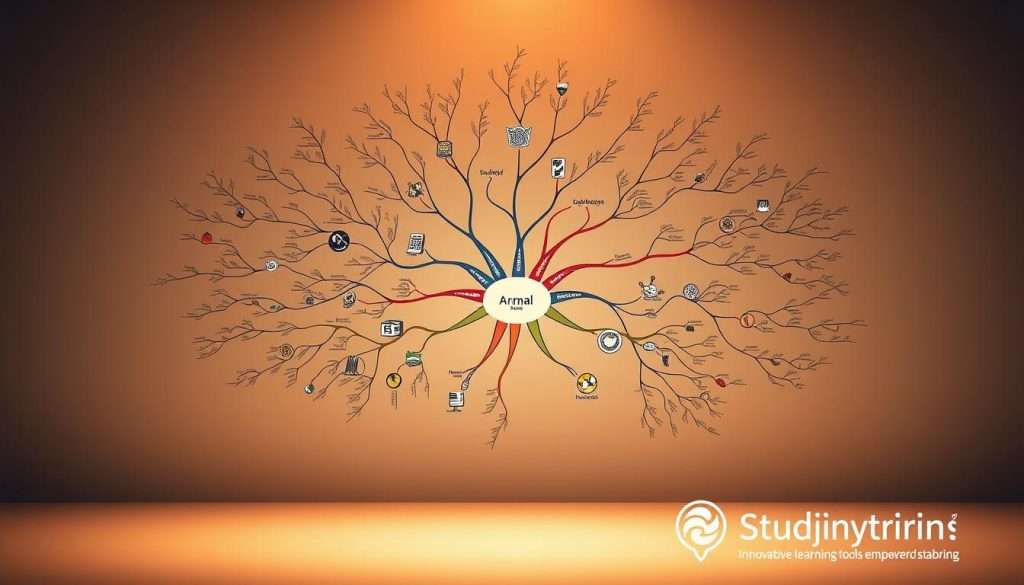Imagine learning at an incredible speed, boosting your learning speed and staying ahead. We’ve all been there, stuck in slow studying, wishing for a better way. What if you could supercharge your learning and reach your goals quicker?
Methods like the Feynman Technique and spaced repetition can really help. By adding these accelerated learning methods to your day, you can reach your goals faster and better.
Key Takeaways
- Discover proven techniques to boost your learning speed
- Learn how to apply accelerated learning methods in your daily routine
- Understand the benefits of using the Feynman Technique and spaced repetition
- Start achieving your goals faster and more efficiently
- Transform your learning experience with these simple yet effective methods
The Science Behind Accelerated Learning
Learning faster isn’t just about working longer hours. It’s about understanding the science behind it. To learn faster, you need to know how your brain handles information and how to make it work better.
How Your Brain Processes Information
Our brains can only hold so much information at a time. To get around this, using chunking helps. It breaks down information into smaller, easier-to-handle pieces. This makes it easier for your brain to process and remember.
The Neuroscience of Fast Learning
Fast learning is all about how our brains remember and think. Studies show that active recall and spaced repetition really boost memory. Knowing how these methods work can help you learn better.
By using the science of fast learning, you can improve memory retention and learn more efficiently. This means understanding the neuroscience of learning and using techniques that match how your brain works.
Why Traditional Learning Methods Fall Short
Traditional learning methods often hinder our progress. We’ve all felt stuck using methods that don’t work. It’s time to change how we learn, whether you’re in school or always learning new things.
Common Learning Pitfalls
Traditional learning often leads to common problems. Passive reading is a big one. If we just read without really getting it, we miss out on remembering it well. Another issue is not using active recall, which helps solidify new knowledge.
The Passive Learning Trap
Falling into the passive learning trap is easy. It’s when we just take in information without doing anything with it. To speed up your learning process, you must actively engage with what you’re learning. Try summarizing what you’ve read or talking about it with others.
By avoiding this trap, you can greatly enhance your study efficiency and avoid common learning pitfalls.
Preparing Your Mind to Learn10x Faster
To learn 10 times faster, your brain needs to be ready. Just like a car needs the right fuel to run well, your brain needs the right setup to learn fast.
Optimal Mental States for Learning
To learn 10x faster, you must be in the right mindset. This means being calm yet focused, known as being “in the zone.” Meditation and deep breathing can help by lowering stress and sharpening your focus.
Physical Preparation for Peak Mental Performance
Being physically fit is key for rapid learning strategies. Regular exercise, enough sleep, and a healthy diet are essential. Exercise improves blood flow to the brain, boosting thinking skills. Sleep helps solidify memories, and a balanced diet keeps your brain healthy.
Creating the Ideal Learning Environment
Your learning space greatly affects your ability to focus and learn. To reach optimal mental states, make your study area quiet, comfy, and free from distractions. Tools like noise-cancelling headphones or apps can help you stay focused.
By focusing on mental readiness, physical health, and a great learning space, you’re set for success. This combination helps you learn better and faster.
The Feynman Technique: Mastering Concepts Through Teaching
The Feynman Technique is a great way to learn and remember things. It makes hard ideas easy by teaching them to others. This method, inspired by Richard Feynman, breaks down complex info into simple parts. It’s a smart way to learn and keep new ideas in your mind.
Step-by-Step Implementation Guide
To use the Feynman Technique, pick a concept you want to learn. Write down what you know about it. Then, find out what you don’t know and research it. Finally, explain it in a way a kid could understand.
Real-World Application Examples
The Feynman Technique works for many subjects, like science, math, history, and literature. For example, if you’re trying to get a scientific theory, explain it to a friend in simple words. This way, you’ll understand it better and remember it longer.
Overcoming Common Obstacles
One big challenge is making hard ideas simple. To beat this, focus on the main points and skip fancy terms unless needed. Practice explaining it to others, changing your words based on their feedback.
Spaced Repetition: The Key to Long-Term Retention
Unlock the secret to remembering everything you learn with spaced repetition. This powerful technique is about to change your study routine.
Spaced repetition is a learning method that reviews material at longer intervals. It helps solidify information in your long-term memory. This method uses the psychological spacing effect, showing that spaced learning is more effective than single sessions.
Creating an Effective Spaced Repetition Schedule
To make the most of spaced repetition, create a schedule that fits you. Start by breaking down the material you want to learn into smaller chunks. Choose an initial review interval, which can be hours, days, or weeks, based on the material’s complexity and your learning speed.
Tip: Start with shorter intervals and increase them as you get more confident with the material.
Digital Tools for Automating Spaced Repetition
Many digital tools can automate spaced repetition, making it easier to follow your schedule. Apps like Anki and Quizlet let you create digital flashcards and set review intervals.
Anki uses a smart algorithm to optimize your review sessions based on your performance.
Combining Spaced Repetition with Other Methods
Spaced repetition works best when combined with other learning techniques. Try active recall by testing yourself before reviewing, or use mind mapping to organize and connect new information.
By adding spaced repetition to your learning routine and mixing it with other methods, you can greatly improve retention. This will help you reach your learning goals.
Speed Reading Techniques That Actually Work
Are you tired of reading slowly? Imagine reading fast and learning more in less time!
To read better, you need to use effective speed reading techniques. One great method is Meta-Guiding. It trains your eyes to move quickly over the page.
Meta-Guiding: Training Your Eyes for Faster Reading
Meta-guiding uses a visual guide like a pointer or finger to help your eyes move. It keeps your focus and stops your eyes from jumping back. This makes you read faster.
- Use a pointer or your finger to guide your eyes.
- Practice regularly to increase your speed.
- Start with simple texts and gradually move to more complex materials.
Chunking Information for Improved Comprehension
Chunking information is another great technique. It breaks down text into smaller parts instead of reading word by word. This makes understanding and remembering easier.
To chunk information well:
- Identify key phrases and concepts.
- Group related information together.
- Practice active recall by summarizing the chunks in your own words.
Common Speed Reading Myths to Avoid
When learning speed reading, it’s important to avoid common myths. For example, the idea that fast reading means you won’t understand is wrong. With the right techniques, you can read quickly and still grasp the material.
By using these speed reading techniques, you’ll study more efficiently and enjoy learning more. So, are you ready to improve your reading skills?

Memory Enhancement Techniques for Rapid Learning
Unlocking your memory’s full potential can change your learning journey. The right strategies can greatly improve how you absorb and remember information.
Building Your First Memory Palace
A Memory Palace, or the Method of Loci, is a great way to remember things. You imagine a place you know well, like your home. Then, you link the information you want to remember to specific spots in that place.
Mnemonic Devices for Different Types of Information
Mnemonic devices are clever ways to remember specific things. For example, acronyms help you remember lists or sequences. Rhymes are good for phrases or formulas. The trick is to make these associations meaningful or memorable to you.
Visualization Strategies to Cement Knowledge
Visualization is a powerful tool for learning and memory. It makes abstract ideas more concrete and easy to remember. Try to link new information to something you already know or make it more engaging and interactive.
| Technique | Description | Benefit |
|---|---|---|
| Memory Palace | Associating information with locations in a familiar space | Improved recall of complex information |
| Mnemonic Devices | Using acronyms, rhymes, or other associations to remember information | Enhanced memory for specific details |
| Visualization | Creating mental images to make information more memorable | Better retention of abstract concepts |
Active Recall: The Most Powerful Learning Strategy
Active recall is a top strategy for better retention and faster learning. It means you actively try to remember information instead of just reading it again. This method strengthens your memory and makes learning new things easier.
Putting Active Recall into Practice
To use active recall, test yourself on what you’ve learned. Make flashcards, take quizzes, or write down key points in your own words. This way, you’re actively working with the information, not just reading it.
Crafting Effective Practice Tests
Make practice tests that focus on important details you might forget. Mix up the types of questions to keep it interesting. You can also use apps for digital flashcards and tests.
Measuring Progress
Track how well you’re doing with active recall. Keep a record of your test scores and note any tough spots. This helps you adjust your study plan to improve where needed.
Mind Mapping for Holistic Understanding
Imagine seeing your thoughts and ideas come to life visually. That’s what mind mapping does. It lets you organize your thoughts in a way that’s easy to grasp and remember. Using visual learning techniques, you can enhance your study efficiency and keep information in your mind better.

Digital vs. Physical Mind Mapping Tools
There are two main ways to do mind mapping: digital tools and physical ones. Digital tools like MindMeister and Coggle are great for sharing and working together. On the other hand, physical tools like notebooks and colored pens offer a hands-on experience. The best choice for you depends on what you like better.
| Tool Type | Advantages | Disadvantages |
|---|---|---|
| Digital | Easy to share, collaborative, accessible anywhere | Requires a device, can be distracting |
| Physical | Tactile experience, no digital distractions, creative freedom | Space limitations, harder to share |
Connecting Ideas for Deeper Learning
Mind mapping is more than just making a visual. It’s about connecting ideas to understand deeply. By linking related concepts, you see how they work together. This way, you remember and recall information better.
“The mind is not a vessel to be filled, but a fire to be kindled.” – Plutarch
Using Color and Images to Enhance Recall
Adding color and images to your mind maps boosts memory. Colors help you tell main topics from subtopics. Images give a visual clue that helps you remember. This multi-sensory method makes your mind maps more engaging and effective.
- Use different colors for main topics and subtopics.
- Incorporate images and icons to represent ideas.
- Experiment with different layouts and structures.
By using these techniques, you can enhance your study efficiency and understand material better. Mind mapping is a powerful tool that changes how you learn.
How to Learn10x Faster with the80/20 Principle
To learn 10x faster, find the 20% of information that gives you 80% of the results. The 80/20 Principle is a great tool for this.
Identifying the Vital 20%
The first step is to find the most important parts of what you’re learning. Look at the material and find the key concepts that matter most.
For example, when learning a new language, focus on common words and phrases. Don’t try to memorize every word in the dictionary.
Practical Examples Across Different Disciplines
The 80/20 Principle works in many areas. In business, focus on the key metrics that lead to success. In programming, learn the most used coding languages and frameworks.
Eliminating Time-Wasting Learning Activities
After finding the vital 20%, cut out the rest. This means getting rid of unnecessary study materials and avoiding distractions.
By using the 80/20 Principle, you can learn more efficiently and Learn10x Faster.
Creating Your Personalized Accelerated Learning System
Now that we’ve looked at different ways to learn faster, it’s time to make your own learning plan. This means picking the best methods for you, adjusting them to fit your learning style, and keeping track of how you’re doing.
Combining Techniques for Maximum Effect
To make a strong learning system, mix techniques like the Feynman Technique, Spaced Repetition, and Active Recall. For example, use the Feynman Technique to grasp tough ideas. Then, use Spaced Repetition to keep those ideas in your mind longer.
| Technique | Purpose | Example |
|---|---|---|
| Feynman Technique | Understand complex concepts | Explain a concept in simple terms |
| Spaced Repetition | Retain information over time | Review material at increasingly longer intervals |
Adapting Methods to Your Learning Style
It’s important to tailor these methods to fit how you learn best. For example, if you learn better by seeing things, add mind mapping and visualization to your plan.
Tracking Progress and Making Adjustments
Keep an eye on how you’re doing and tweak your plan as needed. Use a learning journal or apps to see how well you’re retaining and understanding the material.
By building and improving your own learning system, you’ll learn faster and more effectively.
Conclusion: Your Journey to Becoming a Super Learner
Learning to Learn10x Faster is a journey that needs the right techniques, mindset, and practice. By using the methods we’ve discussed, you’re on your way to becoming a super learner. You’ll be able to absorb and keep information better.
The secret to success is mixing techniques like the Feynman Technique, spaced repetition, and active recall. This creates a learning system that works for you. Keep going on your journey to mastery, and celebrate every small step.
Becoming a super learner is a journey, not a one-time thing. It’s about always getting better and adapting. Stay committed, and you’ll be amazed at what you can learn and do. So, keep going and enjoy the journey of learning and growth!

